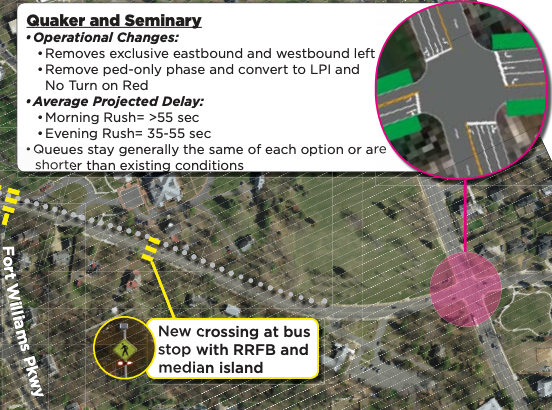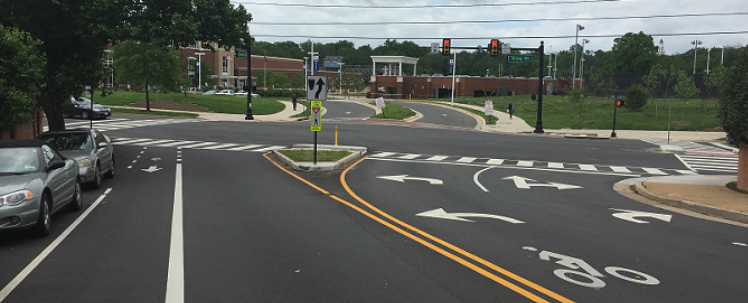What caused a community to push for a less-safe design for Seminary Road?

Speeding is a common problem on Seminary Road. Taken during afternoon rush hour. Image by the author.
The City of Alexandria wants to improve safety and connectivity along a stretch of Seminary Road east of I-395, but multiple local civic associations are opposed to its plan. Welcome to the latest chapter in the battle for a 0.9-mile section of Seminary, where converting a single car lane on a road that’s already too wide has become surprisingly controversial.
Seminary Road is an important connection in Alexandria, but currently vehicle speeds are excessive and it’s inhospitable for people walking or bicycling. The city has been studying how to improve it, and city staff proposed a three-lane design as the best technical option, one of three alternatives they presented in March 2019 for public comment.
Three-lane alternative for Seminary Road. Image by City of Alexandria.
Three-lane alternative for Seminary Road. Image by City of Alexandria.
This configuration would reallocate one of four lanes to provide safe accommodations for all road users, including a center left-turn lane for drivers, buffer space and refuge islands for people who walk or take the bus, and bike lanes for people who bike.
But on June 24, Alexandria’s Traffic and Parking Board voted three to two to recommend a different option that would maintain four lanes for motor vehicles. Multiple civic associations wanted this option, even though city staff said the three-lane option best met its criteria and a majority of speakers at the hearing (46 out of 68) wanted it too.
Why did the Traffic and Parking Board go with a lower-ranked option?
Opponents are worried that a three-lane configuration will cause additional congestion, though that’s not really an issue. City staff noted that traffic counts show it’s well under capacity already. Entrances to this section of roadway are already one lane in each direction, so continuing this and adding a left-turn lane in the middle will maintain traffic flow.
In fact, a similar conversion on King Street in Alexandria in 2016 reduced speeding by 18% without adding congestion, and this type of layout is a Federal Highway Administration (FHWA) proven safety measure. Currently with wide open roadway in front of them, drivers are comfortable with speeding.
Updated King Street. Image by City of Alexandria.
Nonetheless, six civic associations wrote letters advocating for four lanes for motor vehicles. Carter Flemming, President of the Seminary Hill Association, said, “I don’t think that anyone’s opposed to the city encouraging people to use other modes of transportation,” she said. “But, as the article says, the car is still king,” referring to a recent Washington Post article.
So after considering community input, staff presented a “hybrid” alternative as their preferred choice. It contains four lanes for most of the corridor, with three lanes for a 0.4-mile section with roadway space re-allocated to fill a sidewalk gap. Unfortunately, this option does not address speeding, a recognized safety concern in the corridor. Nor does it include a center left-turn lane, bike lanes, or much space for people on foot.
City policies versus survey results
City policies enacted over the past decade or more have boosted progressive transportation, environmental, and traffic safety initiatives. First, the city has a goal for a more multi-modal future. The city’s 2008 Transportation Master Plan integrates walking, bicycling, and transit to boost connectivity and accessibility.
Then in 2011, City officials adopted a Complete Street policy, which says that projects must serve all road users and keep them safe. In April 2016, the City Council approved an update to the 2008 Pedestrian and Bicycle chapters that placed greater emphasis on safety and defined prioritized bike networks and sidewalk projects.
The three-lane alternative for Seminary Road is consistent with all of these policies. It would prioritize safety for all road users, and also implement a portion of a bike network component ranked #9 of 96 in the City’s Transportation Master Plan. Plus, this alternative could be updated to address a sidewalk gap ranked #9 of 43. The Traffic and Parking Board-recommended four-lane alternative would not address safety concerns, nor would it provide a bike network component or sidewalk.
Second, the three-lane option is most in line with Alexandria’s environmental goals. Its Eco-City Charter, one of the first of its kind in the country, was unanimously adopted in June 2008. It led to adoption of an Environmental Action Plan which prioritizes low-carbon mobility options, and the directive to “Develop a holistic city transportation system that puts the health, mobility, and accessibility of ‘people first.’”
The three-lane alternative prioritizes more eco-friendly forms of transportation, while the four-lane alternative prioritizes motor vehicles. The Metropolitan Washington Council of Governments (MWCOG) says, “Transportation sector emissions are the second largest contributor to metropolitan Washington’s GHG emissions, accounting for 41% of total emissions. Emissions from on-road travel are the most significant source of transportation emissions.”
Finally, the three-lane option is better for safety. It will better protect people walking and bicycling, as I’ve discussed, but will also be better for emergency vehicles. While people have voiced concern that this configuration would somehow make it harder for ambulances and fire trucks to get through, the Federal Highway Administration (FHWA) says: “Road Diets do not degrade response times for law enforcement and emergency services. Instead, one simple Road Diet feature can actually improve response times: the two-way, left-turn lane.”
Alexandria’s own fire department said it prefers the three-lane alternative since it provides room for drivers to pull to the curb and extra space for emergency vehicles, if needed, in the center left-turn lane. As the FHWA concludes: “A Road Diet design opens a more predictable and practical path for emergency responders.”
Frustration with traffic has led to confounding results
City policies notwithstanding, 56% of respondents to a city survey in April 2019 voted to maintain four lanes for motor vehicles, while 42% voted for one of two other alternatives with three lanes with bike lanes and buffer space for people on narrow sidewalks. “If you support keeping Seminary Road four lanes and not adding to the city’s gridlock and cut through traffic, contact The Mayor, Vice Mayor and City Council members,” a four-lane proponent posted this week to residents in 26 neighborhoods on NextDoor.
General frustration with congestion is contributing to this attitude. The Washington region has been ranked #2 behind Boston among the most congested urban areas for the past two years. In Northern Virginia, “about one-third of respondents listed reducing traffic congestion and offering more transportation options as their top concerns, followed by affordable housing, job creation, and crime” according to a 2017 survey by the Northern Virginia Transportation Authority.
Alexandria is pursuing numerous initiatives to address congestion, including the Potomac Yard Metro station, Bus Rapid Transit corridors, and planning that prioritizes multi-modal transportation. However, implementation has been slow, and in the meantime there’s been a steady increase in regional and cut-through traffic, especially downtown.
City staff will present the four-lane alternative to the Alexandria City Council in September for a public hearing. A group of residents who live near Seminary Road have requested that a fully-developed three-lane option also be presented. How much weight will the Alexandria City Council give its own agency’s technical evaluation and policies, and how much will it give constituent phone calls and emails in? Stay tuned.
